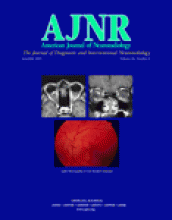Abstract
BACKGROUND AND PURPOSE: The purpose of this study was to examine the efficacy and safety of the 6F Closer S device (Perclose; Redwood City, CA) versus manual compression to close arteriotomy sites after neurointerventional procedures in both virgin vessels and those previously treated with the device.
METHODS: This single-center, multiple-operator, controlled, prospective study included 475 procedures (337 patients) with the device and 79 procedures (79 patients) with manual compression. A substantial number of patients receiving anticoagulation and/or antiplatelet medications were included. Efficacy and safety were evaluated on the basis of the rate of hemostatic success and the incidence of clinically significant complications. The literature was reviewed by using MEDLINE.
RESULTS: Overall success rates were 95% in the device group versus 96% in the manual-compression group (P = 0.78), and clinically relevant complication rates were 0.6% versus 2.5%, respectively (P = 0.15). Success rates significantly declined in vessels previously treated with the device three or more times. However, complication rates did not significantly change. Literature review yielded 12 articles reporting complication rates of 3.2–35% for the device and 2.3%–33.3% for manual compression.
CONCLUSION: The device was safe and effective for closing arteriotomy sites in patients undergoing neurointerventional procedures, including those receiving anticoagulation/antiplatelet therapy or those previously treated with the device one or two times.
- Copyright © American Society of Neuroradiology












